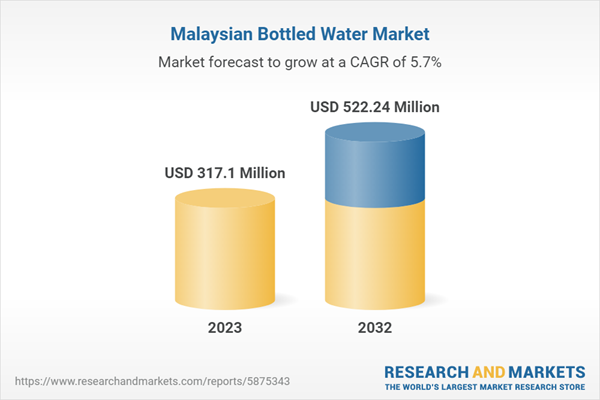Bottled water, packaged drinking water typically sold in plastic or glass bottles, is categorized into two types in Malaysia: Natural Mineral Water (NMW) and Drinking Water (DW).
Malaysia is blessed with abundant water resources, which have been fundamental to the country's socio-economic development over the past decades. As a water-rich nation, Malaysia primarily sources its water from surface water (80.8%), including rivers and dams (17.9%), while groundwater accounts for only 1.2%. Malaysia's tropical climate with high rainfall ensures a constant supply of rainwater, and most households have access to affordable municipal tap water. However, the country has recently experienced a shift in its water supply situation, transitioning from relative abundance to scarcity. Factors such as population growth, urbanization, industrialization, and expanded irrigated agriculture have led to rapidly increasing demands and pressures on water resources, along with heightened water pollution.
Malaysia boasts the highest per capita consumption of bottled water among developing countries, with each Malaysian consuming just under 150 liters annually. Malaysians prefer bottled water for its convenience and often use it as a healthier alternative to sugary drinks. Additionally, the choice to consume bottled water may stem from a general distrust of the quality of municipal tap water.
As the fourth-largest economy in Southeast Asia, Malaysia experienced impressive economic growth of 8.7% in 2022. The country's population is nearly 32.7 million, with a GDP per capita of $12,400, placing it in the upper-middle-income category. Consumption and international trade are vital components of Malaysia's GDP, with total exports and imports reaching RM2.85 trillion (approximately $627 billion) in 2022, marking the second consecutive year surpassing the 2 trillion-ringgit threshold.
From 2018 to 2022, as analyzed, the annual sales revenue of bottled water in Malaysia displayed a fluctuating pattern, experiencing a Compound Annual Growth Rate (CAGR) of 0.03% during this period. In recent years, the size of Malaysia's bottled water market has remained relatively stable. The market experienced a decline in sales revenue in 2020, primarily due to the impact of the COVID-19 pandemic, with sales revenue falling by 10.25%. Subsequently, in 2021 and 2022, the sales revenue of bottled water in the Malaysian market gradually rebounded, reaching approximately $300 million in 2022. the analyst suggests that as the economic impact of the COVID-19 pandemic diminishes, coupled with growing health consciousness and income levels, Malaysia's bottled water industry will continue to experience growth in the future.
The analysis anticipates that the Malaysian bottled water market will expand to a size of US$522 million by 2032, registering a Compound Annual Growth Rate (CAGR) of approximately 5.7% from 2023 to 2032.
Topics covered:
- Overview of the bottled water industry in Malaysia
- Economic and policy environment of the bottled water industry in Malaysia
- What is the impact of COVID-19 on the Malaysian bottled water industry?
- Malaysia Bottled Water Industry Market Size, 2023-2032
- Analysis of Major Malaysian Bottled Water Industry Players
- Key Drivers and Market Opportunities in Malaysia's Bottled Water Industry
- What are the key drivers, challenges and opportunities for the bottled water industry in Malaysia during the forecast period 2023-2032?
- Which are the key players in the Malaysia Bottled Water Industry market and what are their competitive advantages?
- What is the expected revenue of Malaysia Bottled Water Industry market during the forecast period of 2023-2032?
- What strategies have been adopted by the key players in the market to increase their market share in the industry?
- Which segment of the Malaysia bottled water industry market is expected to dominate the market by 2032?
- What are the major unfavorable factors facing the bottled water industry in Malaysia?
Table of Contents
Companies Mentioned
- R O WATER SDN BHD
- LA BOOST HEALTH BEVERAGE MFG SDN BHD
- SPRING FRESH MANUFACTURING SDN BHD
- Nestlé
- Win smith packing sdn bhd
- Life water industries sdn bhd
- VS RO INDUSTRIES (M) SDN BHD
- Eau claire minor water sdn bhd
Methodology
Background research defines the range of products and industries, which proposes the key points of the research. Proper classification will help clients understand the industry and products in the report.
Secondhand material research is a necessary way to push the project into fast progress. The analyst always chooses the data source carefully. Most secondhand data they quote is sourced from an authority in a specific industry or public data source from governments, industrial associations, etc. For some new or niche fields, they also "double-check" data sources and logics before they show them to clients.
Primary research is the key to solve questions, which largely influence the research outputs. The analyst may use methods like mathematics, logical reasoning, scenario thinking, to confirm key data and make the data credible.
The data model is an important analysis method. Calculating through data models with different factors weights can guarantee the outputs objective.
The analyst optimizes the following methods and steps in executing research projects and also forms many special information gathering and processing methods.
1. Analyze the life cycle of the industry to understand the development phase and space.
2. Grasp the key indexes evaluating the market to position clients in the market and formulate development plans
3. Economic, political, social and cultural factors
4. Competitors like a mirror that reflects the overall market and also market differences.
5. Inside and outside the industry, upstream and downstream of the industry chain, show inner competitions
6. Proper estimation of the future is good guidance for strategic planning.

LOADING...
Table Information
| Report Attribute | Details |
|---|---|
| No. of Pages | 60 |
| Published | September 2023 |
| Forecast Period | 2023 - 2032 |
| Estimated Market Value ( USD | $ 317.1 Million |
| Forecasted Market Value ( USD | $ 522.24 Million |
| Compound Annual Growth Rate | 5.6% |
| Regions Covered | Malaysia |
| No. of Companies Mentioned | 8 |









